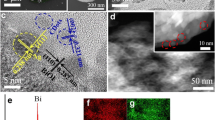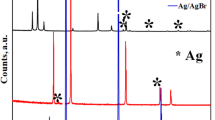Abstract
Environmental pollution and energy shortages seriously restrict the development of society. Photocatalytic oxidation technology can directly use solar energy to drive a series of chemical reactions. It has the advantages of low energy consumption, mild reaction conditions, and no secondary pollution, and is an effective method to solve organic pollutions in water. The key to achieve this process is to find and design efficient photocatalytic materials. In this paper, a novel silver-based metal–organic framework (Ag-MOF) [{Ag(H2btc)}{Ag2(Hbtc)}]n (1) (H3btc = 1,3,5-trimesic acid) is designed that exhibits a high performance in the photocatalytic degradation of methylene blue (MB). The process of photocatalytic degradation of MB conforms to pseudo first-order kinetics, and the rate is the fastest at pH 3 (K = 0.2654). Meanwhile, the photocatalytic mechanism of 1 is analyzed by in situ electron paramagnetic resonance (EPR) and ESI-MS spectra. The results are helpful for in situ research of the photocatalytic mechanism of MOFs.







Similar content being viewed by others
References
A.K. An, J. Guo, E.J. Lee, S. Jeong, Y. Zhao, Z. Wang, and T. Leiknes: PDMS/PVDF hybrid electrospun membrane with superhydrophobic property and drop impact dynamics for dyeing wastewater treatment using membrane distillation. J. Membr. Sci. 525, 57 (2017).
A.B. Albadarin, M.N. Collins, M. Naushad, S. Shirazian, G. Walker, and C. Mangwandi: Activated lignin-chitosan extruded blends for efficient adsorption of methylene blue. Chem. Eng. J. 307, 264 (2017).
R.P. Schwarzenbach, B.I. Escher, K. Fenner, T.B. Hofstetter, C.A. Johnson, U. Von Gunten, and B. Wehrli: The challenge of micropollutants in aquatic systems. Science 313, 1072 (2006).
C.A. Martinez-Huitle and S. Ferro: Electrochemical oxidation of organic pollutants for the wastewater treatment: Direct and indirect processes. Chem. Soc. Rev. 35, 1324 (2006).
S.T. Glassmeyer, E.T. Furlong, D.W. Kolpin, A.L. Batt, R. Benson, J.S. Boone, and H.E. Mash: Nationwide reconnaissance of contaminants of emerging concern in source and treated drinking waters of the United States. Sci. Total Environ. 581, 909 (2017).
A. Zhang, Z. Gu, W. Chen, Q. Li, and G. Jiang: Removal of refractory organic pollutants in reverse-osmosis concentrated leachate by Microwave–Fenton process. Environ. Sci. Pollut. Res. 25, 28907 (2018).
N. Zhang, M.Q. Yang, S. Liu, Y. Sun, and Y.J. Xu: Waltzing with the versatile platform of graphene to synthesize composite photocatalysts. Chem. Rev. 115, 10307 (2015).
K.Q. Lu, X. Xin, N. Zhang, Z.R. Tang, and Y.J. Xu: Photoredox catalysis over graphene aerogel-supported composites. J. Mater. Chem. A 6, 4590 (2018).
X. Xie, N. Zhang, Z.R. Tang, M. Anpo, and Y.J. Xu: Ti3C2Tx MXene as a Janus cocatalyst for concurrent promoted photoactivity and inhibited photocorrosion. Appl. Catal., B 237, 43 (2018).
T. Robinson, G. McMullan, R. Marchant, and P. Nigam: Remediation of dyes in textile effluent: A critical review on current treatment technologies with a proposed alternative. Bioresour. Technol. 77, 247 (2001).
P.E. Stackelberg, E.T. Furlong, M.T. Meyer, S.D. Zaugg, A.K. Henderson, and D.B. Reissman: Persistence of pharmaceutical compounds and other organic wastewater contaminants in a conventional drinking-water-treatment plant. Sci. Total Environ. 329, 99 (2004).
S. Giebner, S. Ostermann, S. Straskraba, M. Oetken, J. Oehlmann, and M. Wagner: Effectivity of advanced wastewater treatment: Reduction of in vitro endocrine activity and mutagenicity but not of in vivo reproductive toxicity. Environ. Sci. Pollut. Res. 25, 3965 (2018).
M.B. Ahmed, J.L. Zhou, H.H. Ngo, W. Guo, N.S. Thomaidis, and J. Xu: Progress in the biological and chemical treatment technologies for emerging contaminant removal from wastewater: A critical review. J. Hazard. Mater. 323, 274 (2017).
L. Yu, M. Han, and F. He: A review of treating oily wastewater. Arabian J. Chem. 10, S1913 (2017).
I. Oller, S. Malato, and J. Sánchez-Pérez: Combination of advanced oxidation processes and biological treatments for wastewater decontamination—A review. Sci. Total Environ. 409, 4141 (2011).
N. Bolong, A.F. Ismail, M.R. Salim, and T. Matsuura: A review of the effects of emerging contaminants in wastewater and options for their removal. Desalination 239, 229 (2009).
W.Z. Tang and H. An: UV/TiO2 photocatalytic oxidation of commercial dyes in aqueous solutions. Chemosphere 31, 4157 (1995).
A.H. Mamaghani, F. Haghighat, and C.S. Lee: Photocatalytic oxidation technology for indoor environment air purification: The state-of-the-art. Appl. Catal., B 203, 247 (2017).
B. Yu, Q. Jiang, W. He, S. Liu, F. Zhou, J. Ji, and H. Chen: Performance study on a novel hybrid solar gradient utilization system for combined photocatalytic oxidation technology and photovoltaic/thermal technology. Appl. Energy 215, 699 (2018).
Y. Song, J. Li, and C. Wang: Modification of porphyrin/dipyridine metal complexes on the surface of TiO2 nanotubes with enhanced photocatalytic activity for photoreduction of CO2 into methanol. J. Mater. Res. 33, 2612 (2018).
S. Kattel, P.J. Ramírez, J.G. Chen, J.A. Rodriguez, and P. Liu: Active sites for CO2 hydrogenation to methanol on Cu/ZnO catalysts. Science 355, 1296 (2017).
M. Wang, Z. Peng, H. Li, Z. Zhao, and X. Fu: C fibers@MoO2 nanoparticles core–shell composite: Highly efficient solar-driven photocatalyst. J. Mater. Res. 33, 685 (2018).
J.T. Yan, M.Q. Xu, B. Chai, H.B. Wang, C.L. Wang, and Z.D. Ren: In situ construction of BiOBr/Ag3PO4 composites with enhanced visible light photocatalytic performances. J. Mater. Res. 32, 1603 (2017).
H.W. Li, H.K. Zhu, M. Wang, X. Min, M.H. Fang, Z.H. Huang, Y.G. Liu, and X.W. Wu: A new Ag/Bi7Ta3O18 plasmonic photocatalyst with a visible-light-driven photocatalytic activity. J. Mater. Res. 32, 3650 (2017).
X. Li, J. Xie, C. Jiang, J. Yu, and P. Zhang: Review on design and evaluation of environmental photocatalysts. Front. Environ. Sci. Eng. 12, 14 (2018).
Y. Ma, Z. Wang, X. Xu, and J. Wang: Review on porous nanomaterials for adsorption and photocatalytic conversion of CO2. Chin. J. Catal. 38, 1956 (2017).
X.L. Yang, Y. Wang, X. Xu, Y. Qu, X. Ding, and H. Chen: Surface plasmon resonance-induced visible-light photocatalytic performance of silver/silver molybdate composites. Chin. J. Catal. 38, 260 (2017).
F. Chen, H. Yang, W. Luo, P. Wang, and H. Yu: Selective adsorption of thiocyanate anions on Ag-modified g-C3N4 for enhanced photocatalytic hydrogen evolution. Chin. J. Catal. 38, 1990 (2017).
S.N. Zhao, X.Z. Song, S.Y. Song, and H.J. Zhang: Highly efficient heterogeneous catalytic materials derived from metal–organic framework supports/precursors. Coord. Chem. Rev. 337, 80 (2017).
L. Zhu, X.Q. Liu, H.L. Jiang, and L.B. Sun: Metal–organic frameworks for heterogeneous basic catalysis. Chem. Rev. 117, 8129 (2017).
J. Ye, L. Gagliardi, C.J. Cramer, and D.G. Truhlar: Computational screening of MOF-supported transition metal catalysts for activity and selectivity in ethylene dimerization. J. Catal. 360, 160 (2018).
U. Mueller, M. Schubert, F. Teich, H. Puetter, K. Schierle-Arndt, and J. Pastre: Metal–organic frameworks—Prospective industrial applications. J. Mater. Chem. 16, 626 (2006).
J. Huang, X.B. Zhang, H.Y. Song, C.X. Chen, F.Q. Han, and C.C. Wen: Protonated graphitic carbon nitride coated metal–organic frameworks with enhanced visible-light photocatalytic activity for contaminants degradation. Appl. Surf. Sci. 441, 85 (2018).
F. Ye, H.F. Li, H.T. Yu, S. Chen, and X. Quan: Hydrothermal fabrication of few-layer MoS2 nanosheets within nanopores on TiO2 derived from MIL-125(Ti) for efficient photocatalytic H2 evolution. Appl. Surf. Sci. 426, 177 (2017).
G. Lan, Y.Y. Zhu, S.S. Veroneau, Z. Xu, D. Micheroni, and W. Lin: Electron injection from photoexcited metal–organic framework ligands to Ru2 secondary building units for visible-light-driven hydrogen evolution. J. Am. Chem. Soc. 140, 5326 (2018).
S. Liu, Y. Wang, L. Ma, and H. Zhang: Ni2P/ZnS(CdS) core/shell composites with their photocatalytic performance. J. Mater. Res. 33, 3580 (2018).
C.W. Kung, C.O. Audu, A.W. Peters, H. Noh, O.K. Farha, and J.T. Hupp: Copper nanoparticles installed in metal–organic framework thin films are electrocatalytically competent for CO2 reduction. ACS Energy Lett. 2, 2394 (2017).
D. Huang, X. Wu, J. Tian, X. Wang, Z. Zhou, and D. Li: Assembling of a novel 3D Ag(I)-MOFs with mixed ligands tactics: Syntheses, crystal structure and catalytic degradation of nitrophenol. Chin. Chem. Lett. 29, 845 (2018).
A.Q. Ma and L.G. Zhu: Diverse silver(I) sulfobenzoate coordination polymers and their recycling property as homogeneous catalyst in oxygenation of sulfide. RSC Adv. 4, 14691 (2014).
K. Martín-Betancor, S. Aguado, I. Rodea-Palomares, M. Tamayo-Belda, F. Leganés, R. Rosal, and F. Fernández-Piñas: Co, Zn, and Ag-MOFs evaluation as biocidal materials towards photosynthetic organisms. Sci. Total Environ. 595, 547 (2017).
G. Wyszogrodzka, B. Marszałek, B. Gil, and P. Dorożyński: Metal–organic frameworks: Mechanisms of antibacterial action and potential applications. Drug Discovery Today 21, 1009 (2016).
J.L. Bredas, R. Silbey, D.S. Boudreaux, and R.R. Chance: Chain-length dependence of electronic and electrochemical properties of conjugated systems: Polyacetylene, polyphenylene, polythiophene, and polypyrrole. J. Am. Chem. Soc. 105, 6555 (1983).
Y. Shinde, S. Wadhai, A. Ponkshe, S. Kapoor, and P. Thakur: Decoration of Pt on the metal free RGO-TiO2 composite photocatalyst for the enhanced photocatalytic hydrogen evolution and photocatalytic degradation of pharmaceutical pollutant β blocker. Int. J. Hydrogen Energy 43, 4015 (2018).
X. Li, R. Shen, S. Ma, X. Chen, and J. Xie: Graphene-based heterojunction photocatalysts. Appl. Surf. Sci. 430, 53 (2018).
M. Xing, J. Zhang, B. Qiu, B. Tian, M. Anpo, and M. Che: A Brown mesoporous TiO2−x/MCF composite with an extremely high quantum yield of solar energy photocatalysis for H2 evolution. Small 11, 1920 (2015).
Z. Tong, D. Yang, T. Xiao, Y. Tian, and Z. Jiang: Biomimetic fabrication of g-C3N4/TiO2 nanosheets with enhanced photocatalytic activity toward organic pollutant degradation. Chem. Eng. J. 260, 117 (2015).
S. Li, C. Wei, Y. Hu, H. Wu, and F. Li: In situ synthesis and photocatalytic mechanism of a cyano bridged Cu(I) polymer. Inorg. Chem. Front. 5, 1282 (2018).
O.V. Dolomanov, L.J. Bourhis, R.J. Gildea, J.A. Howard, and H. Puschmann: OLEX2: A complete structure solution, refinement and analysis program. J. Appl. Crystallogr. 42, 339 (2009).
Acknowledgments
This work is supported by the project of education department of Guangxi province (No. YB2014331), the project of undergraduate teaching reform of higher education in Guangxi (No. 2018JGA254) and the subject of “12th Five-Year” Plan of Guangxi Education Science (No. 2015C408).
Author information
Authors and Affiliations
Corresponding authors
Supplementary Material
43578_2019_34060991_MOESM1_ESM.doc
Supplementary Material for High-efficiency Photocatalytic Performance and Mechanism of Silver-based Metal-Organic Framework (approximately 1.14 MB)
Rights and permissions
About this article
Cite this article
Yin, XJ., Zhu, LG. High-efficiency photocatalytic performance and mechanism of silver-based metal–organic framework. Journal of Materials Research 34, 991–998 (2019). https://doi.org/10.1557/jmr.2018.507
Received:
Accepted:
Published:
Issue Date:
DOI: https://doi.org/10.1557/jmr.2018.507




